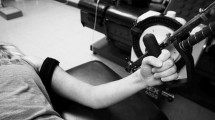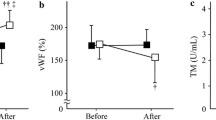Abstract
Greater venous compliance is associated with attenuation of the tolerance response to orthostatic stress and reduced incidence of venous diseases. Resistance training induces tolerance to orthostatic challenge and the growth of capillaries, which may lead to negative and positive effects on venous compliance, respectively. It has not been confirmed, however, whether habitual resistance training positively or negatively affects venous compliance. We compared the forearm venous compliance in resistance-trained men with age-matched controls. Eleven resistance-trained middle-aged men (37.7 ± 1.5 years) and 12 age-matched sedentary controls (36.7 ± 1.6 years) were studied. Forearm venous compliance was measured in subjects in the supine position by inflating a venous collecting cuff placed around the upper arm to 60 mmHg for 8 min and then decreasing cuff pressure to 0 mmHg at a rate of 1 mmHg/s. Forearm venous compliance was determined using the first derivative of the pressure–volume relation during cuff pressure reduction (compliance = β1 + 2β2 × cuff pressure). Forearm venous compliance at 20 mmHg cuff pressure was 16% greater in the resistance-trained group than in the age-matched sedentary controls (0.097 ± 0.005 vs. 0.083 ± 0.004 ml/dl/mmHg, P < 0.05). Forearm venous compliance was positively related to forearm venous volume (r = 0.643, P = 0.0009), but not forearm muscle mass (r = 0.391, P = 0.0648). In conclusion, the present study suggests that (1) the resistance-trained men have greater forearm venous compliance than age-matched controls, and (2) the higher forearm venous compliance in the resistance-trained men may be explained by greater forearm venous capacitance.



Similar content being viewed by others
References
ACSM (1998) American College of Sports Medicine Position Stand. Exercise and physical activity for older adults. Med Sci Sports Exerc 30:992–1008
American Diabetes Association (2000) Diabetes mellitus and exercise. Diabetes Care 23(Suppl 1):S50–S54
Bouissou H, Julian M, Pieraggi M, Maurel E, Thiers J, Louge L (1991) Structure of healthy and varicose veins. Return Circulation and Norepinephrine: An Update: 139–150
Brilla LR, Stephens AB, Knutzen KM, Caine D (1998) Effect of strength training on orthostatic hypotension in older adults. J Cardpulm Rehabil 18:295–300
Burkhart TA, Arthurs KL, Andrews DM (2009) Manual segmentation of DXA scan images results in reliable upper and lower extremity soft and rigid tissue mass estimates. J Biomech 42:1138–1142
Carter JR, Ray CA, Downs EM, Cooke WH (2003) Strength training reduces arterial blood pressure but not sympathetic neural activity in young normotensive subjects. J Appl Physiol 94:2212–2216
Convertino VA, Doerr DF, Flores JF, Hoffler GW, Buchanan P (1988) Leg size and muscle functions associated with leg compliance. J Appl Physiol 64:1017–1021
Delaney EP, Young CN, Disabatino A, Stillabower ME, Farquhar WB (2008) Limb venous tone and responsiveness in hypertensive humans. J Appl Physiol 105:894–901
Dinenno FA, Tanaka H, Monahan KD, Clevenger CM, Eskurza I, DeSouza CA, Seals DR (2001) Regular endurance exercise induces expansive arterial remodelling in the trained limbs of healthy men. J Physiol 534:287–295
Donnelly JE, Blair SN, Jakicic JM, Manore MM, Rankin JW, Smith BK (2009) American College of Sports Medicine Position Stand. Appropriate physical activity intervention strategies for weight loss and prevention of weight regain for adults. Medicine and science in sports and exercise. Med Sci Sports Exerc 41:459–471
Galetta F, Franzoni F, Virdis A, Ghiadoni L, Taddei S, Salvetti A, Santoro G (2006) Endothelium-dependent vasodilation and carotid artery wall remodeling in athletes and sedentary subjects. Atherosclerosis 186:184–192
Glynn RJ, Rosner B (2005) Comparison of risk factors for the competing risks of coronary heart disease, stroke, and venous thromboembolism. Am J Epidemiol 162:975–982
Glynn RJ, Ridker PM, Goldhaber SZ, Zee RY, Buring JE (2007) Effects of random allocation to vitamin E supplementation on the occurrence of venous thromboembolism: report from the Women’s Health Study. Circulation 116:1497–1503
Halliwill JR, Minson CT, Joyner MJ (1999) Measurement of limb venous compliance in humans: technical considerations and physiological findings. J Appl Physiol 87:1555–1563
Hather BM, Tesch PA, Buchanan P, Dudley GA (1991) Influence of eccentric actions on skeletal muscle adaptations to resistance training. Acta Physiol Scand 143:177–185
Hepple RT, Mackinnon SL, Thomas SG, Goodman JM, Plyley MJ (1997) Quantitating the capillary supply and the response to resistance training in older men. Pflugers Arch 433:238–244
Hernandez JP, Franke WD (2004) Age- and fitness-related differences in limb venous compliance do not affect tolerance to maximal lower body negative pressure in men and women. J Appl Physiol 97:925–929
Kawano H, Tanaka H, Miyachi M (2006) Resistance training and arterial compliance: keeping the benefits while minimizing the stiffening. J Hypertens 24:1753–1759
Kawano H, Tanimoto M, Yamamoto K, Sanada K, Gando Y, Tabata I, Higuchi M, Miyachi M (2008) Resistance training in men is associated with increased arterial stiffness and blood pressure but does not adversely affect endothelial function as measured by arterial reactivity to the cold pressor test. Exp Physiol 93:296–302
Lightfoot JT, Torok DJ, Journell TW, Turner MJ, Claytor RP (1994) Resistance training increases lower body negative pressure tolerance. Med Sci Sports Exerc 26:1003–1011
MacDougall JD, Tuxen D, Sale DG, Moroz JR, Sutton JR (1985) Arterial blood pressure response to heavy resistance exercise. J Appl Physiol 58:785–790
Miyachi M, Tanaka H, Yamamoto K, Yoshioka A, Takahashi K, Onodera S (2001) Effects of one-legged endurance training on femoral arterial and venous size in healthy humans. J Appl Physiol 90:2439–2444
Miyachi M, Donato AJ, Yamamoto K, Takahashi K, Gates PE, Moreau KL, Tanaka H (2003) Greater age-related reductions in central arterial compliance in resistance-trained men. Hypertension 41:130–135
Miyachi M, Kawano H, Sugawara J, Takahashi K, Hayashi K, Yamazaki K, Tabata I, Tanaka H (2004) Unfavorable effects of resistance training on central arterial compliance: a randomized intervention study. Circulation 110:2858–2863
Miyachi M, Tanaka H, Kawano H, Okajima M, Tabata I (2005) Lack of age-related decreases in basal whole leg blood flow in resistance-trained men. J Appl Physiol 99:1384–1390
Miyatani M, Kawano H, Masani K, Gando Y, Yamamoto K, Tanimoto M, Oh T, Usui C, Sanada K, Higuchi M, Tabata I, Miyachi M (2008) Required muscle mass for preventing lifestyle-related diseases in Japanese women. BMC Public Health 8:291
Monahan KD, Ray CA (2004) Gender affects calf venous compliance at rest and during baroreceptor unloading in humans. Am J Physiol 286:H895–H901
Monahan KD, Dinenno FA, Seals DR, Halliwill JR (2001) Smaller age-associated reductions in leg venous compliance in endurance exercise-trained men. Am J Physiol 281:H1267–H1273
Olsen H, Lanne T (1998) Reduced venous compliance in lower limbs of aging humans and its importance for capacitance function. Am J Physiol 275:H878–H886
Pratley R, Nicklas B, Rubin M, Miller J, Smith A, Smith M, Hurley B, Goldberg A (1994) Strength training increases resting metabolic rate and norepinephrine levels in healthy 50- to 65-yr-old men. J Appl Physiol 76:133–137
Rakobowchuk M, McGowan CL, de Groot PC, Bruinsma D, Hartman JW, Phillips SM, MacDonald MJ (2005a) Effect of whole body resistance training on arterial compliance in young men. Exp Physiol 90:645–651
Rakobowchuk M, McGowan CL, de Groot PC, Hartman JW, Phillips SM, MacDonald MJ (2005b) Endothelial function of young healthy males following whole body resistance training. J Appl Physiol 98:2185–2190
Rowell LB (1993) Human cardiovascular control. Oxford University Press, New York
Schantz P (1982) Capillary supply in hypertrophied human skeletal muscle. Acta Physiol Scand 114:635–637
Smith ML, Raven PB (1986) Cardiovascular responses to lower body negative pressure in endurance and static exercise-trained men. Med Sci Sports Exerc 18:545–550
Tanaka H, Dinenno FA, Monahan KD, Clevenger CM, DeSouza CA, Seals DR (2000) Aging, habitual exercise, and dynamic arterial compliance. Circulation 102:1270–1275
Turner IC, McNally MA, O’Connell BM, Cooke EA, Kernohan WG, Mollan RA (2000) Numerical model of deep venous thrombosis detection using venous occlusion strain gauge plethysmography. Med Biol Eng Comput 38:348–355
Williams MA, Haskell WL, Ades PA, Amsterdam EA, Bittner V, Franklin BA, Gulanick M, Laing ST, Stewart KJ (2007) Resistance exercise in individuals with and without cardiovascular disease: 2007 update: a scientific statement from the American Heart Association Council on Clinical Cardiology and Council on Nutrition, Physical Activity, and Metabolism. Circulation 116:572–584
Young CN, Stillabower ME, DiSabatino A, Farquhar WB (2006) Venous smooth muscle tone and responsiveness in older adults. J Appl Physiol 101:1362–1367
Zoeller RF, Angelopoulos TJ, Thompson BC, Wenta MR, Price TB, Thompson PD, Moyna NM, Seip RL, Clarkson PM, Gordon PM, Pescatello LS, Devaney JM, Gordish-Dressman H, Hoffman EP, Visich PS (2009) Vascular remodeling in response to 12 wk of upper arm unilateral resistance training. Med Sci Sports Exerc 41:2003–2008
Acknowledgments
We wish to thank Dr. Motoyuki Iemitsu for supporting our study. This work was supported by Grant-in-Aid for Scientific Research 13780041 (to M. Miyachi) and Grant-in-Aid for Scientific Research 21700707 (to H. Kawano) from the Japan Society for the Promotion of Science.
Author information
Authors and Affiliations
Corresponding author
Additional information
Communicated by Keith George.
Rights and permissions
About this article
Cite this article
Kawano, H., Tanimoto, M., Yamamoto, K. et al. Greater forearm venous compliance in resistance-trained men. Eur J Appl Physiol 110, 769–777 (2010). https://doi.org/10.1007/s00421-010-1557-9
Accepted:
Published:
Issue Date:
DOI: https://doi.org/10.1007/s00421-010-1557-9




